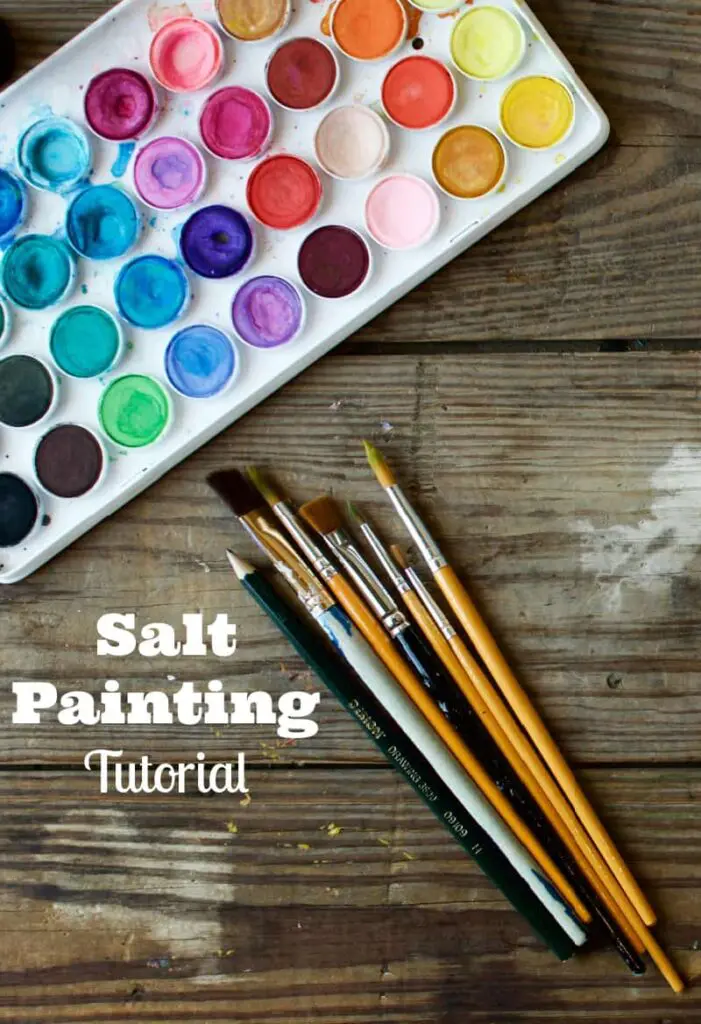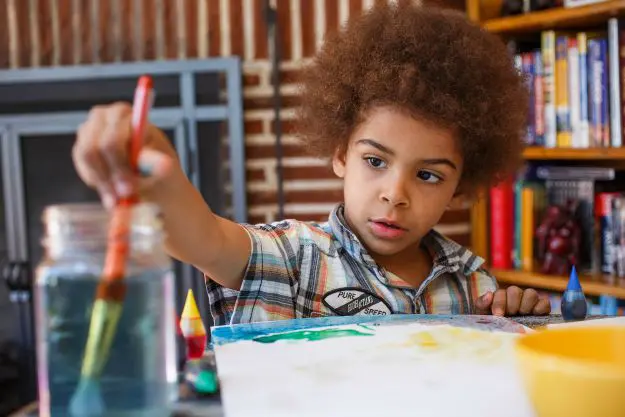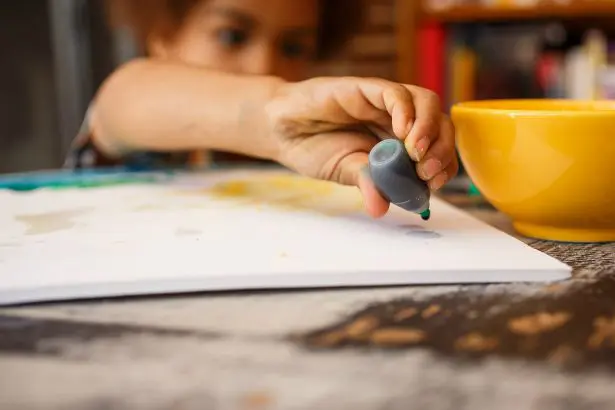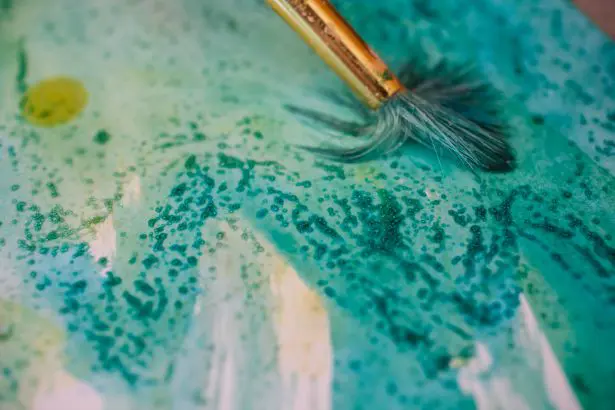The sky has provided inspiration for many artist from Van Gogh to Dali. Whether it is a pale sunrise, a cloudy midday, a rosy sunset or a blue starry night, the sky makes a beautiful painting. Your child will have fun painting what he or she sees in nature. I love helping children express their creative side so I am so happy to share this salt painting for kids tutorial. This art project was provided by KinderCare Learning Centers. Salt painting is a fun, creative art activity where salt is used to create textured designs. It’s often used as a craft for kids but can also be an artistic medium for all ages.
This art project for kids is about free-form expression. Using the salt paint, encourage your child to create the sky as he sees it or the sun that lives inside his heart! Kids are so creative. You may be surprised to see what they imagine as the sky. The watercolor salt painting will have a shiny finish when it dries. That will add another fun element to this art project.
Easy Salt Paint Art Project For Kids Tutorial:

What You Will Need To Paint With Salt:
- Table Salt or Sea Salt
- Paint Brushes
- Food Coloring or Watercolor Paint
- School Glue (white glue)
- Tag Board or Watercolor Paper
- Jar of Water
- Cookie Sheet Or Large Plastic Bag
How To Make A Shiny Watercolor Salt Painting Art Masterpiece:
Here is how to do salt painting:
- Place tag board or watercolor paper onto a cookie sheet or large plastic bag to prevent a mess as the salt paint may bleed through the paper.
- Allow the child to use the school glue to cover paper in a fun pattern for the sky (think stars or clouds or swirls).
- Have your child liberally cover the glue with salt and then shake off any excess salt. The salt sticks to the glue, creating raised, textured lines. Allow a few moments to dry.
- Let your child drip a few drops of food coloring or liquid water color onto the tag board, making sure to focus on the glued areas so that the salt will absorb the color. If using food coloring, your child can dip a paint brush in a cup of water and add drips of water to the food color spots for a to see the swirls of lighter color it forms.
- Tilt the tray so the color rolls around the canvas, creating a beautiful, vibrant sky. The salt absorbs the color, creating a beautiful blend of shades with a unique effect.
- Add some more salt to the food coloring or water color to enhance the sparkle effect of the salt paint art project.
Salt paint is like a mix between a science experiment and an art project. It is so much fun for kids of all ages to sprinkle salt, mix different colors, and see what happens. Another fun idea for this salt art project is to use the same steps to make a spider web pattern or ocean theme.
Conclusion
Simply experimenting with a new artistic medium, like salt paint, is exciting for kids. Encourage your child’s art endeavors as a way to build self esteem and remember that art is the eye of the beholder. The shiny salt paint art project will make a great addition to your refrigerator gallery.
Salt painting is popular because of its simplicity, texture, and the mesmerizing way the colors blend across the salt. It’s a great sensory and creative activity for kids, enhancing their motor skills and sparking creativity.
To make this a really special, fun activity for you and your child- remember to talk with your child throughout the activity. Tell your child about the most beautiful skies you’ve ever seen, or reminisce about rainstorms you watched on the porch when you were little. What kind of weather does your child like best? When does the sun look prettiest to your child?
When you are done with this salt paint activity, don’t forget to display the finished artwork. Watercolor painting is a great way to explore color mixing. I hope you enjoyed this easy salt paint art project. The arts are such a fun way for children to learn. For more fun art project ideas to do with kids, see ideas below.
Related Arts & Crafts Posts:
Watercolor Painting With Ice Cubes




Sunny says
I love doing art projects with my 3 boys, especially simple ones. It looks like we would have everything we need to do this sea salt painting activity here at home!
Ourfamilyworld says
My kids were thrilled with this epsom salt painting project. It is always fun to try something new!
Daisy says
I’ve never heard of salt paint art until now. This is super cute! I should try it with my 5 year old!
Ty @ Mama of 3 Munchkins says
I can’t believe I had never heard of salt painting before. This salt glue and watercolor experiment was something my kids totally enjoyed. We will be doing this again soon.
Liz Mays says
I did that once with the kids and they loved it. It turns out so neat! We used liquid watercolor paints and epsom salt. Thanks for sharing these new salt painting ideas for us to try.
Krystal says
Thanks for this salt painting preschool tutorial. I have a little artist so I will have to try this salt and paint art project with him. This looks perfect for younger children.
Dr Abhinandan says
What a fun salt painting art project for kids! It uses basic household materials like salt, glue, and watercolor paints to create textured, colorful artwork. The process involves drawing with glue, sprinkling salt over it, and then adding watercolor, which spreads through the salt for a vibrant effect. This project promotes creativity while being easy to set up and clean. It’s ideal for children to explore their artistic side while learning new techniques.
Chik Chik says
This is such a creative and fun idea for kids! I love how salt painting combines art and a bit of science, making it both an engaging and educational project. Your step-by-step instructions are easy to follow, and I appreciate the tips on how to use watercolors to enhance the effect. This is definitely something I’m excited to try with my little ones! We enjoy simple art projects with everyday materials. Thanks for sharing this awesome activity.